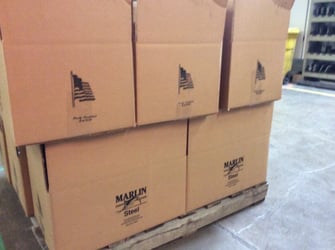 Sooner or later, every manufacturer has to deal with the dreaded manufacturing bottleneck: that point in production or shipping when products start to pile up and cannot move on. These points of throttled production occur when there is more demand placed on a production resource than it has the capacity to handle.
Sooner or later, every manufacturer has to deal with the dreaded manufacturing bottleneck: that point in production or shipping when products start to pile up and cannot move on. These points of throttled production occur when there is more demand placed on a production resource than it has the capacity to handle.
Clearing the obstacles that create chokepoints so that production and shipping can flow smoothly is a huge challenge for many manufacturers. After all, your production capacity is limited to the speed of your slowest chokepoint.
With this in mind, where are the chokepoints in your manufacturing process?
Here are a few examples of manufacturing chokepoints that might exist in your production process, as well as ideas for how to resolve them:
Chokepoint #1: Any Time You’re Manually Switching Parts Baskets
The more complicated a given process is, the more likely it is that a production bottleneck will occur within that process.
One common chokepoint in multi-phase production processes is the moving of parts from one type of container to another for dealing with specialized parts finishing processes.
For example, a pharmaceutical company might need to parts from an ultrasonic parts cleaning machine to a sterilization machine to kill germs. The basket that they use for ultrasonic parts cleaning might not have the heat resistance needed to survive the sterilization process, so they would need to spend time moving parts from one basket to the next.
This creates a production bottleneck, as items in the production line behind the point where workers are manually handling products have to wait for less efficient manual labor to empty one basket and move the contents to another one in a careful manner so that parts don’t get damaged.
One of the best ways to prevent this kind of bottleneck is to use a pats cleaning basket that is optimized to handle as many of your processes as possible. By avoiding having to use multiple baskets, you can save time and labor spent on swapping parts baskets.
Chokepoint #2: Processes that have Long Lead Times & Low Capacities
Another common chokepoint is any production step that has a long lead time but a low capacity for products.
For example, a parts drying process that takes place after a wash cycle might consume a considerable amount of time per part. If said drying process can only hold one load of parts at a time, then you would likely have to hold production back so that parts wouldn’t sit wet outside of the drying process for too long.
In this situation, it might be necessary to tweak the production process itself, either finding a way around the drying process itself, or integrating a new drying process that can handle continuous batch operation to allow you to keep parts flowing without stopping the drying process.
Another solution to a slow production step might be to add more channels/workstations for that step. However, simply doubling the number of stations might not be feasible, as this increases the amount of floor space the bottlenecked production process takes up on your factory floor.
Chokepoint #3: Shipping Parts
 Sometimes, manufacturers and their customers alike forget about shipping times when plotting out the efficiency of the production process. It does little good to have a fast production process if there are excessive shipping delays that keep products from reaching clients.
Sometimes, manufacturers and their customers alike forget about shipping times when plotting out the efficiency of the production process. It does little good to have a fast production process if there are excessive shipping delays that keep products from reaching clients.
For example, say that you can make 200 loads of product each day, but only have the shipping capacity to send out 100 loads/day. In this situation, you would quickly run into a situation where you would have to stop production because there would be nowhere left to put the excess product you’re making.
Adding more shipping capacity can be a daunting prospect. Some manufacturers might choose to use their own shipping trucks, in which case they would need to double the size of their fleet. This can quickly get expensive, as it would double the company’s maintenance costs for shipping. If the production surplus is only to meet temporary or seasonal demands, this would be incredibly wasteful of money.
Another option is to use third-party shipping companies. Using these services may be more expensive than having a private fleet of shipping vehicles (they incur the same expenses, and have to turn a profit), but this strategy allows your company to scale their shipping to meet productivity and demand more easily.
Dealing with Chokepoints
Naturally, not every production process will be the same. There are unique challenges to every company’s current process that can create production bottlenecks and slow production down.
The easiest way to find production bottlenecks and resolve them is to map out your production process, making sure to include every last step. Take some time to analyze each production step to see how many parts per hour can pass through each step.
Looking at an analysis of each step allows you to identify which production processes are moving slowly. Once you’ve identified the chokepoints, examine those processes to see what it is that is causing the production bottleneck.
After establishing an understanding of why a particular process is causing a production slowdown, jot down a list of ideas for improving that process to eliminate the bottleneck. Asking production line workers for ideas here can be helpful, as they should be intimately familiar with the process and may already have a few good ideas for improving production speed.
Eliminating chokepoints so that you can maximize productivity may not always be easy. However, continuously working to improve productivity is what separates the best from the rest in the manufacturing world.
Learn how Marlin Steel helped other manufacturers to resolve production bottlenecks by reading the case study at the link below:



.gif)


